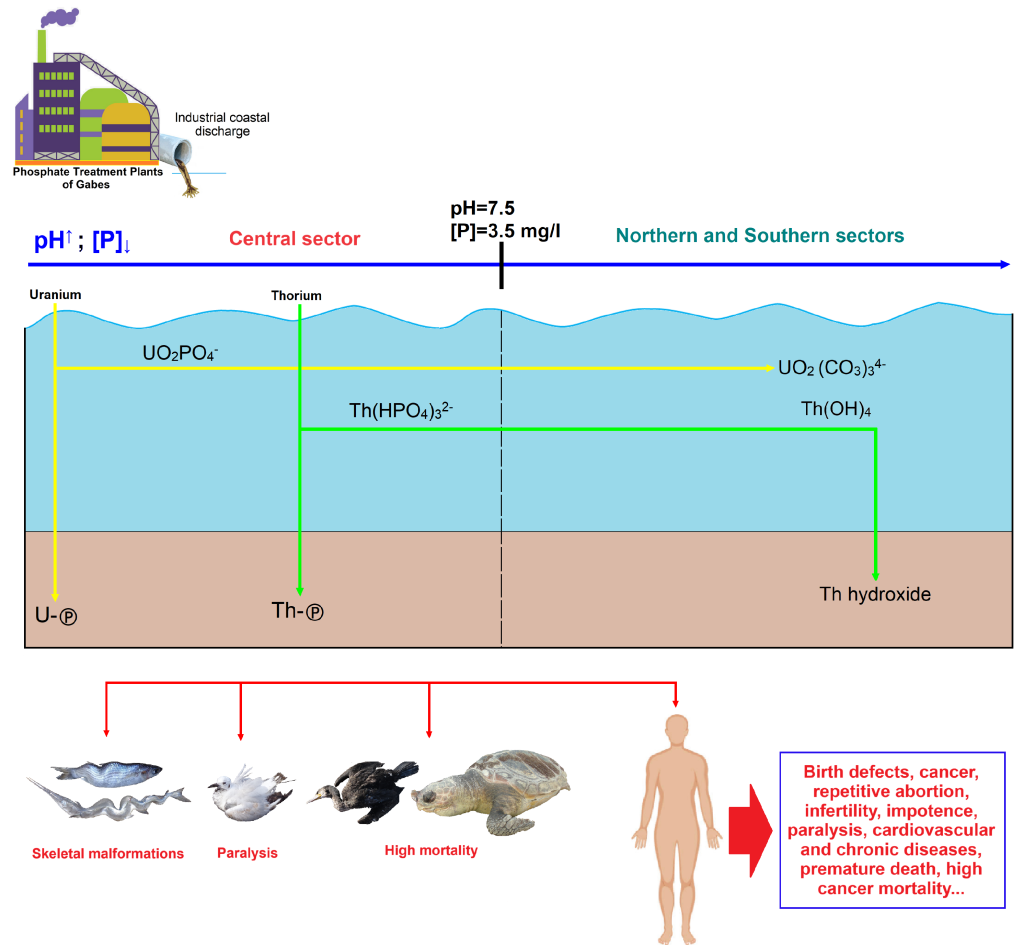Uranium and thorium in coastal sediments in the central Gulf of Gabès (SE Tunisia): alarming contamination with environmental and health impacts
The central part of the Gulf of Gabès (SE Tunisia) is one of the most chemically and radioactively polluted sites in the Mediterranean, and indeed worldwide, due to massive discharges of phosphogypsum and other industrial waste over several decades (1972). This new study analyses, for the first time, the spatial distribution, geochemical behaviour and environmental and health risks associated with the accumulation of uranium (U) and thorium (Th) in coastal sediments. The results reveal an alarming level of contamination, favoured by interactions with organic matter and the chemistry of marine waters (pH and phosphate levels). The study highlights the threats to marine biodiversity (paralysis, mass mortality and malformations) as well as the increased risks to human health (cancers, congenital malformations, cardiovascular disease, infertility, etc.). Urgent action is needed to limit these impacts and put in place sustainable management strategies for this naturally vulnerable area of the Mediterranean.
This recent study, carried out with the participation of researchers from Géosciences Environnement Toulouse (GET), highlights the worrying contamination of coastal sediments in the central Gulf of Gabès (SE Tunisia) by uranium (U) and thorium (Th), two radioactive elements resulting from industrial discharges of phosphogypsum, a radiochemical by-product of phosphoric acid production, which has been dumped untreated in the Gabès sea since 1972 in the form of gypsum slurry.

The results reveal a significant accumulation of these two radioactive elements in coastal sediments, particularly near the industrial waste discharge zone. Geochemical modelling shows a positive correlation between U and Th, indicating a common source (phosphogypsum waste) and similar geochemical behaviour (precipitation from seawater). Geochemical analysis shows that their spatial dispersion is strongly influenced by the proximity of coastal outlets for industrial waste, the impact of port developments and enrichment in organic matter, to which is added, in the case of uranium, the low pH and high phosphorus levels of seawater. These two elements are trapped in coastal sediments, increasing their residence time and their potential to contaminate the marine food chain. This contamination represents a direct threat to marine ecosystems, with serious effects often observed, such as the high mortality rate of certain species (e.g. the loggerhead turtle (Caretta) and the turtle (Caretta)): Loggerhead turtle (Caretta caretta), Great black-backed gull (Chroicocephalus genei), Yellow-legged gull (Larus michahellis), and Great cormorant (Phalacrocorax carbo)) as well as malformations for other marine species (example: blue swimming crab (Portunus segnis) and golden mullet (Liza aurata)).In addition, the risks to human health are also major, with potential exposure to serious pathologies, including cancers (lung, kidney, prostate, bone, etc.), cardiovascular diseases, as well as reproductive disorders (sterility, impotence, etc.) and development disorders (congenital malformations), with premature excess mortality observed in particular among residents living near phosphate processing plants in Gabès (Chatt Sidi Abd Essalam, Ghannouch and Bouchemma).
Given this situation, the study highlights the urgent need to adopt measures to ban industrial phosphate discharges (and other industrial waste), improve environmental monitoring and develop sustainable management solutions to limit the impact of this pollution on the environment and local populations.
Contacts GET: Michel Grégoire et Sylvie Castet









